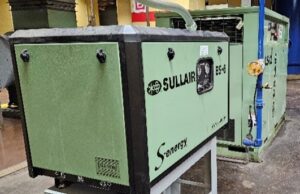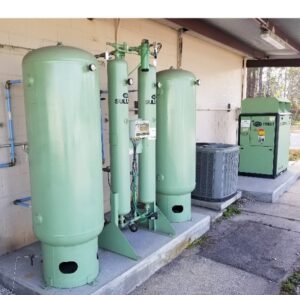 Designing an efficient compressed air system involves careful planning and consideration of several key factors. The ultimate goal when designing your compressed air system is to ensure optimal performance, reliability, and safety.
Designing an efficient compressed air system involves careful planning and consideration of several key factors. The ultimate goal when designing your compressed air system is to ensure optimal performance, reliability, and safety.
To achieve the ideal compressed air system set up, consider our most important tips:
- Equipment Size and Capacity
Selecting the right size and capacity of equipment is essential for optimizing the performance and efficiency of a compressed air system.
If you’re not sure where to start, check out our last article on where to start when you’re in the market for a compressed air system. In a nutshell, you’ll want to bear these things in mind:
- Air quality requirements
The quality of air that your application requires (legal or industry requirements) - Air power requirements
How much air power do you need to operate your equipment? - Application requirements
The type of air compressor you need will be dictated by your industrial application (oil free screw, oil flooded screw, centrifugal, etc.)
- Location of Power Source
A seemingly small detail that packs a big punch is the location of your power source in relation to your system. Ideally, the system should be positioned close to the primary power supply to minimize installation costs and voltage drops.
- Indoor vs. Outdoor Environment
The choice between an indoor or outdoor environment for your compressed air system depends on several factors:
 Environmental Conditions: Outdoor installations expose the system to weather elements such as rain, snow, and extreme temperatures. In such cases, the system must be housed in a weatherproof enclosure to protect it from moisture and temperature fluctuations.
Environmental Conditions: Outdoor installations expose the system to weather elements such as rain, snow, and extreme temperatures. In such cases, the system must be housed in a weatherproof enclosure to protect it from moisture and temperature fluctuations.- Space and Ventilation: Indoor installations require adequate ventilation to dissipate heat generated by compressors and to ensure proper air circulation. Limited indoor space may necessitate compact equipment or modular designs to maximize efficiency without compromising safety.
- Noise Considerations: Compressors can be noisy, so locating them in an outdoor environment or in a soundproofed enclosure indoors helps minimize noise pollution in the workplace.
Ultimately, you’ll want to make sure that your compressed air system environment is safe and will allow your system to function at optimal capacity. As long as these two elements are present, you’ll be in a good position to move forward with your design.
- Maintenance and Accessibility
Maintenance is no small factor in the design of your compressed air system. Prolonging equipment lifespan and minimizing production downtime often comes down to your routine maintenance plan.
- Service Accessibility: Ensure easy access to all components for routine maintenance, inspections, and repairs. This includes providing adequate clearance around equipment and incorporating serviceable filters, valves, and drains.
- Monitoring and Control: Implement monitoring systems to track system performance, detect leaks, and optimize energy usage. Automated controls can help adjust compressor operations based on demand, reducing energy consumption during periods of low usage.
Investing time in thoughtful design pays dividends in terms of reduced operating costs, improved productivity, and enhanced workplace safety—a true testament to the importance of meticulous planning in industrial infrastructure.
To make the most out of your planning and to ensure that all considerations are being made, contact our team!
Blake & Pendleton has been assessing, servicing, and distributing compressed air systems for over 50 years. We’d love to be a part of your design project and ensure that you are being as efficient as possible!

 Environmental Conditions: Outdoor installations expose the system to weather elements such as rain, snow, and extreme temperatures. In such cases, the system must be housed in a weatherproof enclosure to protect it from moisture and temperature fluctuations.
Environmental Conditions: Outdoor installations expose the system to weather elements such as rain, snow, and extreme temperatures. In such cases, the system must be housed in a weatherproof enclosure to protect it from moisture and temperature fluctuations.